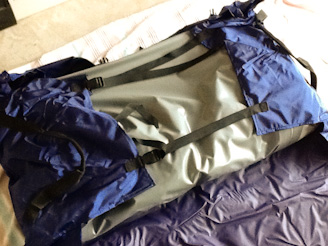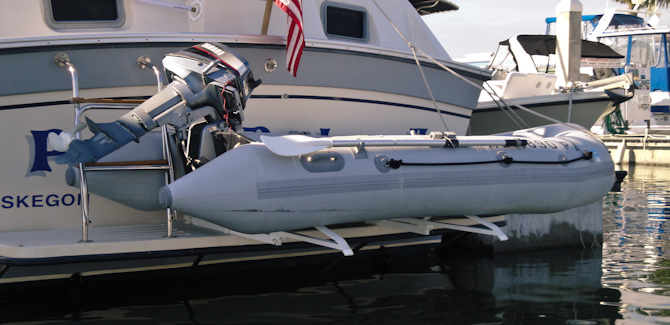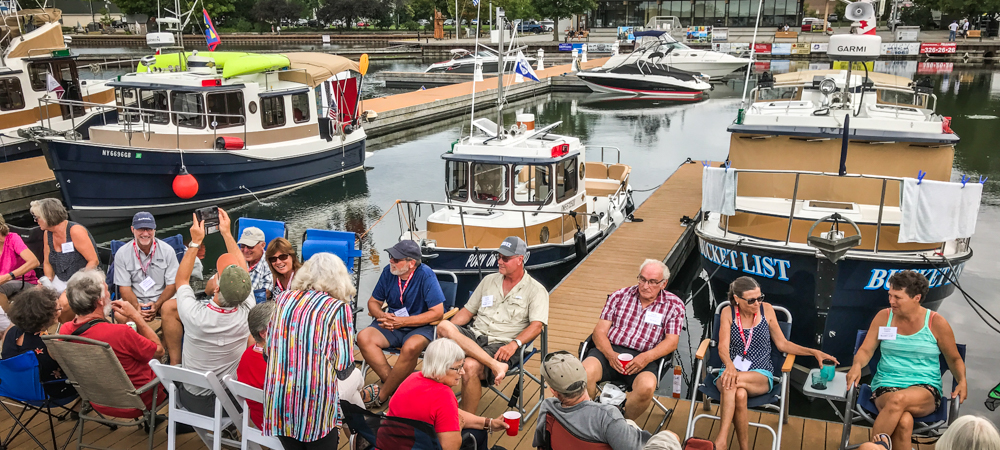Looking for a Worthy Boat to Take On the Great Loop Adventure? We received a…

Dinghy Davit Decision
Lisa and I gave a great deal of thought to the purchase of our Ranger Tug and GMC tow truck but, until recently, we never gave much thought to the dinghy we’d need and how we’d transport it on and off of the water. We finally had some boating downtime over the holidays and were able to do some research after a great deal of thought settled on a small 7′ 7″ Achilles inflatable, with a soft bottom, made of Hypalon material and powered by a Tohatsu 4 HP 4 stroke outboard. It arrived in a neat little package (above). We wanted to have a dinghy that was lightweight, narrower than our boat, and one that was easy to disassemble and stow when it came time to trailer our boat to a new cruising ground.
With the dinghy purchase accomplished, our next mission was to figure out how to transport it while underway on the water. We’ve used the davit system davit before, where the dinghy mounts at the rear of the transom and folds up to it, and is supported by stays (below and below-left). With this option, you either have to take the outboard off and stow it in the cockpit or purchase an adaptor that lets the outboard pivot to stay in an upright position when the dinghy is pulled up from the water. The problem with the davit option is that the uprighted dinghy hinders the view off the transom while cruising.



Our research provided another interesting mounting option made by Hurley Marine called a Hurley Davit (above-right). This option lets you pull the dinghy up onto the transom horizontally by providing support extensions that come off the swim platform. I think this is a viable option however I have no personal experience and have not seen many in use. We came across this boat, Tuggin Aweigh, at the Florida Ranger Tug February 2012 Rendezvous at Moss Marina in Fort Myers Beach.
In the meantime we’ve decided, while our research continues, to tow our dinghy behind Kismet while we’re cruising. No reason to rush into making a hasty decision before we know more about the options available.
The trick to towing the dinghy is to use a floating nylon line and a couple of floats to keep the tow line out of the prop. Sailors, being the frugal bunch they are, have been doing it this way for years. So, as long as the dinghy is towed far enough behind the boat (out of our wake) and we pull it up to the swim platform when slowing down or before docking or anchoring, I don’t see any reason why this won’t work, at least until we come up with a better option.













Have you considered mounting it on top of the cabin.
Hi James! Not really. Our goal was to be able to keep the motor on the dinghy when loading onto boat. It really depends on available man-power to lift and load and we are trying to make it easier on our bodies. This set-up works great for us, plus there is nothing obstructing our view off the back deck when dinghy is loaded.
Lisa
I have read stories of towed dinghy flipping upside down while underway with the outboard in place. Has this Ben an issue e with ya’ll. Love your story. Greg
Hello Greg, thanks for making contact with us. I read up on towing a dinghy and had similar thoughts as you’ve asked. I found out that if you tow the dinghy just beyond the crest that it rides very well. In the short time we’vebeen doing this we’ve experienced boat wakes and 2 to 3-foot seas and the towed dinghy handled very well. With all of this said if we were heading out to cross Lake Michigan or another large body of water we would either disassemble and stow the dinghy or stow the thing in the cockpit or fold it up against the transom – this is what we’d consider up until the time we make another dinghy mounting decisions.